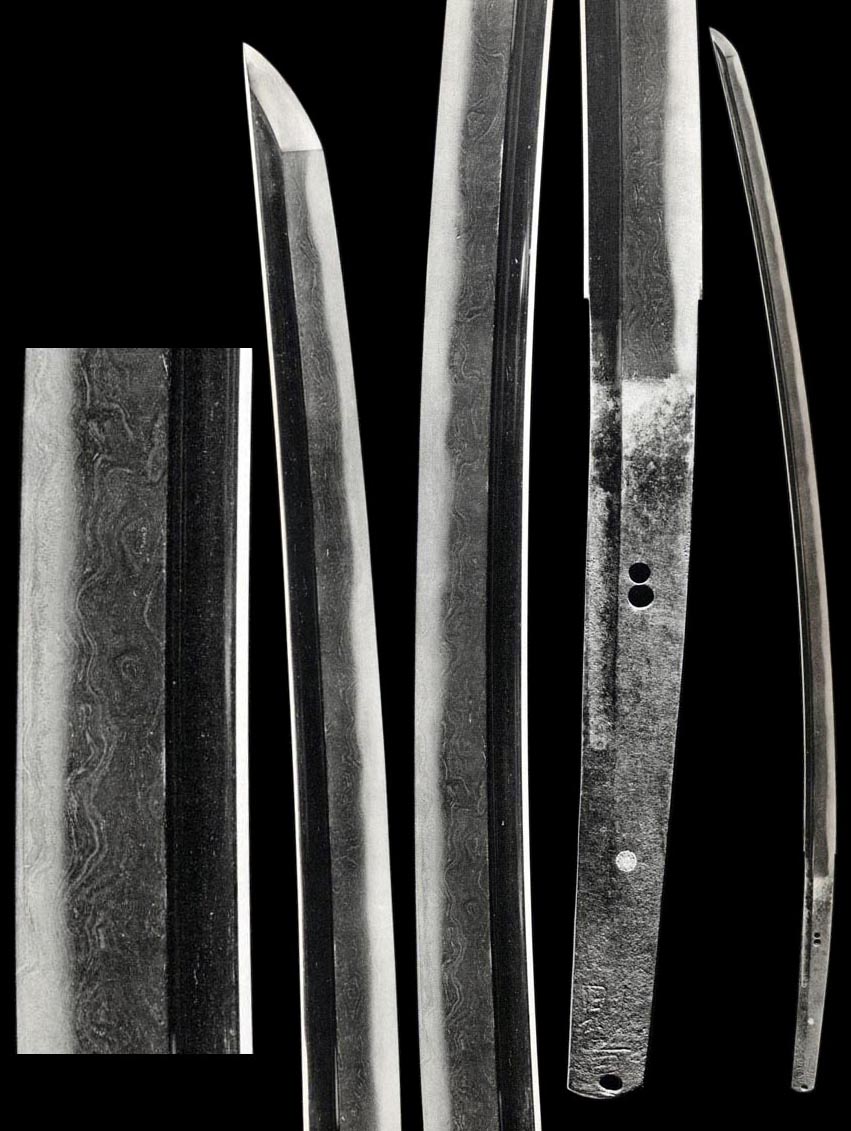ETCHU NORISHIGE
Unique MATSUKAWA "Pine-bark"and UZU-MAKI HADA
"dressed in whirlpools" has CHIKEI and JI-NIE.
KO-MIDARE with ASHI, KO-GUNOME with valleys and
SUNAGASHI in NIE. NIE can be large. KINSUJI.
BOSHI:KO-MARU, KAEN, TOGARI.
SOSHU masters come to the HOKURIKU
"The Ten Students" - See Ten Students
GOFUKU GO NORISHIGE EN-KEI 1308 (SAGAMI) GEN-KYO 1321
|________________________ _________________________ ________
____|____ __|_____ ___|____ |
SHIGEKUNI(1) KEM-MU 1334 TOMONORI(1) KEM-MU 1334 MASANOBU |
(NOBUKUNI 3: same) ________|_____ TEI-WA 1345 |
____|____ SAKON TOMONORI(2) TEI-JI 1362 |
SHIGEKUNI(3) ______|_____ |
O-EI 1394 UDA TOMONORI(3) EI-TOKU 1381 |
___________________________ ______|
________ ___|____ ____|____
TOMOHIRO(1) TEI-JI 1362 SANEKAGE(1) TEI-JI 1362 SUKESHIGE
___|____ ___|_____ _________ TEI-JI 1362
TOMOHIRO(2) O-EI 1394 SHIGEKUNI(2) MITSUMUNE
EI-TOKU 1381 EI-TOKU 1381
NORISHIGE EN-KEI (t:SHINTOGO KUNIMITSU): A member of the SOSHU
revolution. Legend and old lessons has the world suckling
MASAMUNE, whose work and reputation are stark. However
the power and subtlety of HAMON and intricate beauty of
his CHIKEI show the true stature of NORISHIGE as brother
student under KUNIMITSU and his own man. Among the SOSHU
he is ICHI-DAN - highest level. Although specializing in
TANTO, his long-swords are thought superior.
TACHI: Signed blades are few. SUGATA is classic. Thin KASANE
gives a longish feeling to an otherwise normal KISSAKI.
Correct and normal NIKU. IHORI or MITSU-MUNE.
TANTO: Curveless, 7 to 8 SUN, MITSU-MUNE or possibly longer,
TAKENOKO-like (slightly UCHIZORI) IHORI-MUNE. Lengthening
of the KISSAKI is seen in TANTO as well. CHIKEI defines
UZU patterns of hard and soft steel in his unique
MATSUKAWA-no-HADA. JI-NIE is found. He is known for a
JI-BA style HITATSURA where small TOBIs seem to
splatter-up into the JI. HAMON may be KO-MIDARE with
ASHI, KO-MIDARE, or a KO-GUNOME, NOTARE mix that appears
a dynamically balanced "Jumble." NIE GUNOME-MIDARE with
SUNAGASHI has NIJUBA, YUBASHIRI and KINSUJI. MIDARE-KOMI
BOSHI. KAEN,TOGARI & KO-MARU.
MEI: NORISHIGE
SAEKI NORISHIGE
SAEKI NORISHIGE SAKU
ETCHU-no-KUNI NORISHIGE
SAGAMI-no-KUNI JUNIN NORISHIGE
ETCHU-no-KUNI NEI-GORI GOFUKU JU SAEKI NORISHIGE
ETCHU-no-KUNI NEI-GORI GOFUKU GO JU SAEKI NORISHIGE
Tokubetsu Juyo Norishige
Tokubetsu Juyo Norishige
Tokubetsu Juyo Norishige
KOKUHO NORISHIGE National Treasure
NAGASA: 8.2 SUN MOTO-HABA: 6.6 BU
SORI: UCHI-ZORI MOTO-KASANE: 2 BU
NAKAGO: 2 SUN 6
HIRA-TSUKURI, IHORI-MUNE TANTO. SUGATA style is narrow
with thick KASANE. MATSUKAWA "Pine-bark" ITAME HADA is
exemplified by the strongest CHIKEI. Writhing KINSUJI and
INAZUMA hide and seek in a NOTARE CHOJI mix that rolls
together. Small SHIMA-BA clings in the MONOUCHI.
His work is described as MYO, or wondrous.
FURISODE "KIMONO-sleeve" NAKAGO with three MEKUGI-ANA of
varied size, from multiple mountings, and his two-
character MEI.
|
|

|
KOKUHO
NORISHIGE

|
|


